Effect of Y on Recrystallization Behavior in Non-Oriented 4.5 wt% Si Steel Sheets
Abstract
:1. Introduction
2. Experimental
3. Results and Discussion
3.1. Effect of Y Content on the Magnetic Properties and Textures of Final Sheets
3.2. Effect of Y Content on Texture Evolution
3.3. Effect of Y Inclusion on Recrystallization Behavior
3.4. Nucleation and Growth of {001} 〈130〉 and {114} 〈481〉 Grains
4. Conclusions
Author Contributions
Funding
Institutional Review Board Statement
Informed Consent Statement
Data Availability Statement
Conflicts of Interest
References
- Zhang, B.; Liang, Y.F.; Wen, S.B.; Wang, S.; Shi, X.J.; Ye, F.; Lin, J.P. High-strength low-iron-loss silicon steels fabricated by cold rolling. J. Magn. Magn. Mater. 2019, 474, 51–55. [Google Scholar] [CrossRef]
- Zu, G.Q.; Zhang, X.M.; Zhao, J.W.; Wang, Y.Q.; Yan, Y.; Li, C.G.; Cao, G.M.; Jiang, Z.Y. Fabrication and properties of strip casting 4.5 wt% Si steel thin sheet. J. Magn. Magn. Mater. 2017, 424, 64–68. [Google Scholar] [CrossRef]
- Li, F.; Li, H.; Wu, Y.; Zhao, D.; Peng, B.; Huang, H.; Zheng, S.; You, J. Effect of precipitates on grain growth in non-oriented silicon steel. J. Mater. Res. 2017, 32, 2307–2314. [Google Scholar] [CrossRef]
- Hou, C.K.; Liao, C.C. Effect of Cerium Content on the Magnetic Properties of Non-oriented Electrical Steels. ISIJ Int. 2008, 48, 531–539. [Google Scholar] [CrossRef] [Green Version]
- Wan, Y.; Chen, W.Q.; Wu, S.J. Effects of Lanthanum and Boron on the Microstructure and Magnetic Properties of Non-oriented Electrical Steels. High Temp. Mater. Proc. 2014, 33, 115–121. [Google Scholar] [CrossRef]
- Wan, Y.; Chen, W.Q.; Wu, S.J. Effect of lanthanum content on microstructure and magnetic properties of non-oriented electrical steels. J. Rare Earth. 2013, 31, 89–95. [Google Scholar] [CrossRef]
- Shi, C.J.; Jin, Z.L.; Ren, H.P.; You, J.L. Effect of lanthanum on recrystallization behavior of non-oriented silicon steel. J. Rare Earth. 2017, 35, 309–314. [Google Scholar] [CrossRef]
- Qin, J.; Zhou, Q.Y.; Zhao, H.B.; Zhao, H.J. Effects of yttrium on the microstructure, texture, and magnetic properties of non-oriented 6.5 wt% Si steel sheets by a rolling process. Mater. Res. Express 2021, 8, 066103. [Google Scholar] [CrossRef]
- He, Z.H.; Sha, Y.H.; Gao, Y.K.; Chang, S.T.; Zhang, F.; Zuo, L. Recrystallization texture development in rare-earth (RE)-doped non-oriented silicon steel. J. Iron Steel Res. Int. 2020, 27, 1339–1346. [Google Scholar] [CrossRef]
- Park, J.T.; Szpunar, J.A. Evolution of recrystallization texture in nonoriented electrical steels. Acta Mater. 2003, 51, 3037–3051. [Google Scholar] [CrossRef]
- Barnett, M.R.; Kestens, L. Formation of {111} <110> and {111} <112> Textures in Cold Rolled and Annealed IF Sheet Steel. ISIJ Int. 1999, 39, 923–929. [Google Scholar] [CrossRef]
- Wang, L.M.; Qin, L.; Ji, J.W.; Lan, D.N. New study concerning development of application of rare earth metals in steels. J. Alloy. Compd. 2006, 408–412, 384–386. [Google Scholar] [CrossRef]
- Li, L.F.; Yang, W.Y.; Sun, Z.Q. Dynamic Recrystallization of Ferrite with Particle-Stimulated Nucleation in a Low-Carbon Steel. Met. Mater. Trans. A 2013, 44, 2060–2069. [Google Scholar] [CrossRef]
- Zu, G.Q.; Zhang, X.M.; Zhao, J.W.; Wang, Y.Q.; Cui, Y.; Yan, Y.; Jiang, Z.Y. Analysis of {411}<148>recrystallisation texture in twin-roll strip casting of 4.5 wt% Si non-oriented electrical steel. Mater. Lett. 2016, 180, 63–67. [Google Scholar] [CrossRef]
- Wang, X.Y.; Jiang, J.T.; Li, G.A.; Wang, X.M.; Shao, W.Z.; Zhen, L. Particle-stimulated nucleation and recrystallization texture initiated by coarsened Al2CuLi phase in Al–Cu–Li alloy. J. Mater. Res. Technol. 2021, 10, 643–650. [Google Scholar] [CrossRef]
- Xu, Y.B.; Zhang, Y.X.; Wang, Y.; Li, C.G.; Cao, G.M.; Liu, Z.Y.; Wang, G.D. Evolution of cube texture in strip-cast non-oriented silicon steels. Scr. Mater. 2014, 87, 17–20. [Google Scholar] [CrossRef]
- Cheng, L.; Zhang, N.; Yang, P.; Mao, W.M. Retaining {100} texture from initial columnar grains in electrical steels. Scr. Mater. 2012, 67, 899–902. [Google Scholar] [CrossRef]
- Rios, P.R.; Jr, F.S.; Sandim, H.R.Z.; Plaut, R.L.; Padilha, A.F. Nucleation and growth during recrystallization. Mat. Res. 2005, 8, 225–238. [Google Scholar] [CrossRef] [Green Version]
- Liu, D.F.; Qin, J.; Zhang, Y.H.; Wang, Z.G.; Nie, J.C. Effect of yttrium addition on the hot deformation behavior of Fe–6.5 wt%Si alloy. Mat. Sci. Eng. A 2020, 797, 140238. [Google Scholar] [CrossRef]
- Yang, C.Y.; Luan, Y.K.; Li, D.Z.; Li, Y.Y. Effects of rare earth elements on inclusions and impact toughness of high-carbon chromium bearing steel. J. Mater. Sci. Technol. 2019, 35, 1298–1308. [Google Scholar] [CrossRef]
- Robson, J.D.; Henry, D.T.; Davis, B. Particle effects on recrystallization in magnesium–manganese alloys: Particle-stimulated nucleation. Acta Mater. 2009, 57, 2739–2747. [Google Scholar] [CrossRef]
- Li, H.Z.; Liu, Z.Y.; Wang, X.L.; Ren, H.M.; Li, C.G.; Cao, G.M.; Wang, G.D. {114} <481> Annealing texture in twin-roll casting non-oriented 6.5 wt% Si electrical steel. J. Mater. Sci. 2017, 52, 247–259. [Google Scholar] [CrossRef]
- Sanjari, M.; He, Y.L.; Hilinski, E.J.; Yue, S.; Kestens, L.A.I. Development of the {113}<uvw>texture during the annealing of a skew cold rolled non-oriented electrical steel. Scr. Mater. 2016, 124, 179–183. [Google Scholar] [CrossRef]
- Rajmohan, N.; Szpunar, J.A. An analytical method for characterizing grain boundaries around growing goss grains during secondary recrystallization. Scr. Mater. 2001, 44, 2387–2392. [Google Scholar] [CrossRef]
- Zhang, Y.H.; Yang, J.F.; Qin, J.; Zhao, H.B. The effect of grain size before cold rolling on the magnetic properties of thin-gauge non-oriented electrical steel. Mater. Res. Express 2021, 8, 016303. [Google Scholar] [CrossRef]
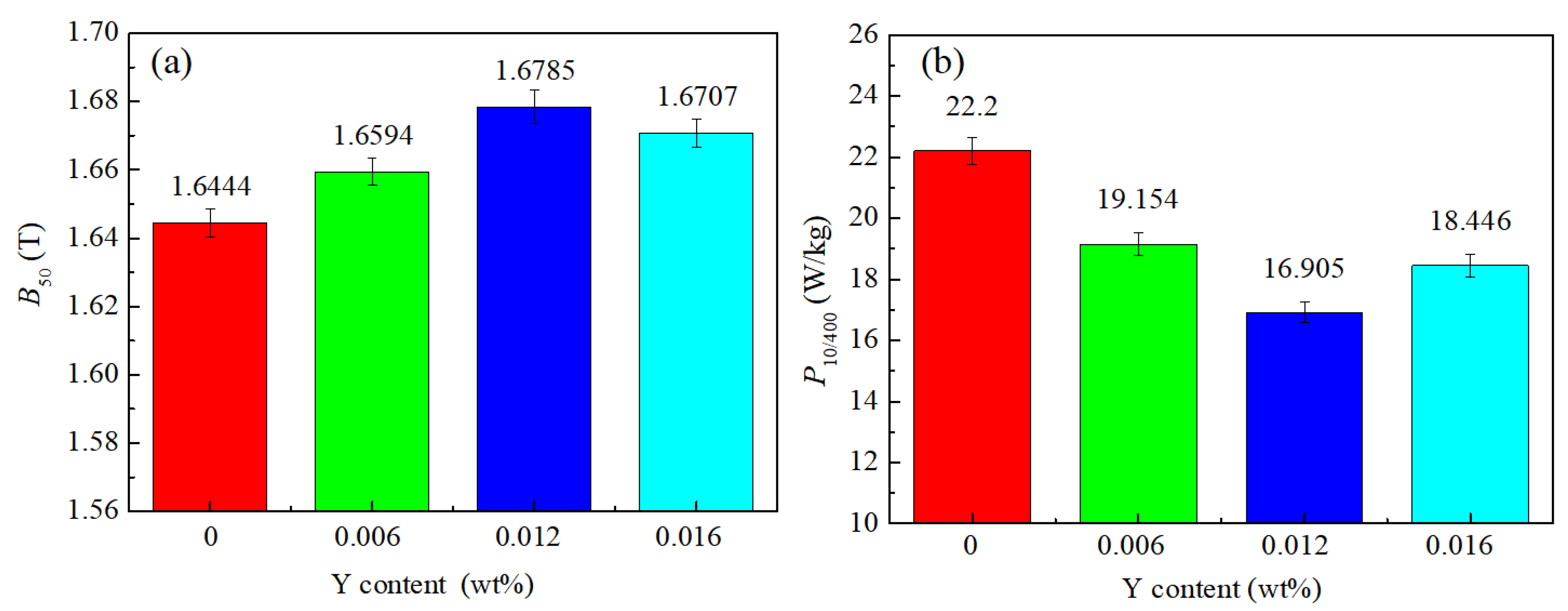
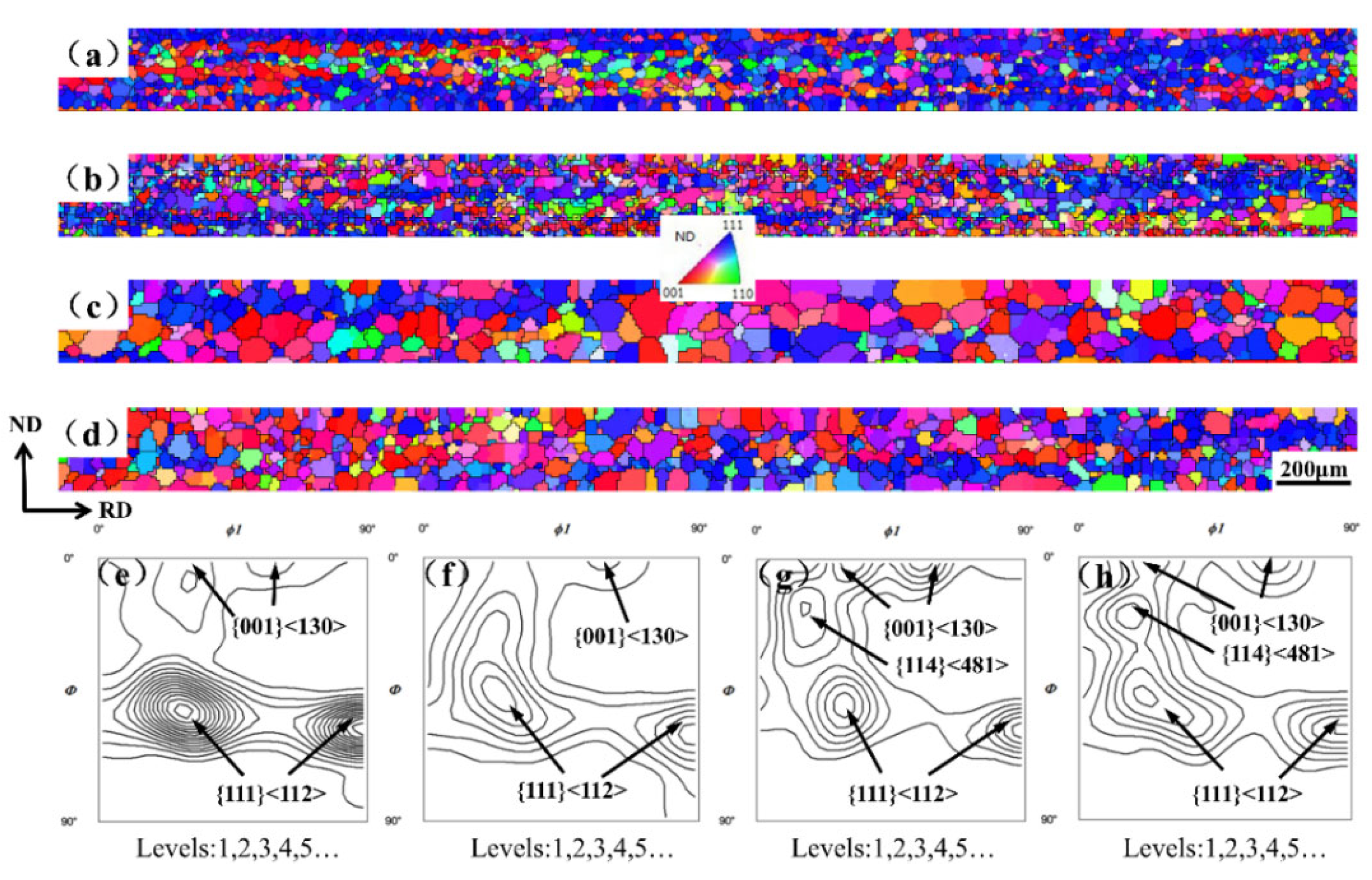
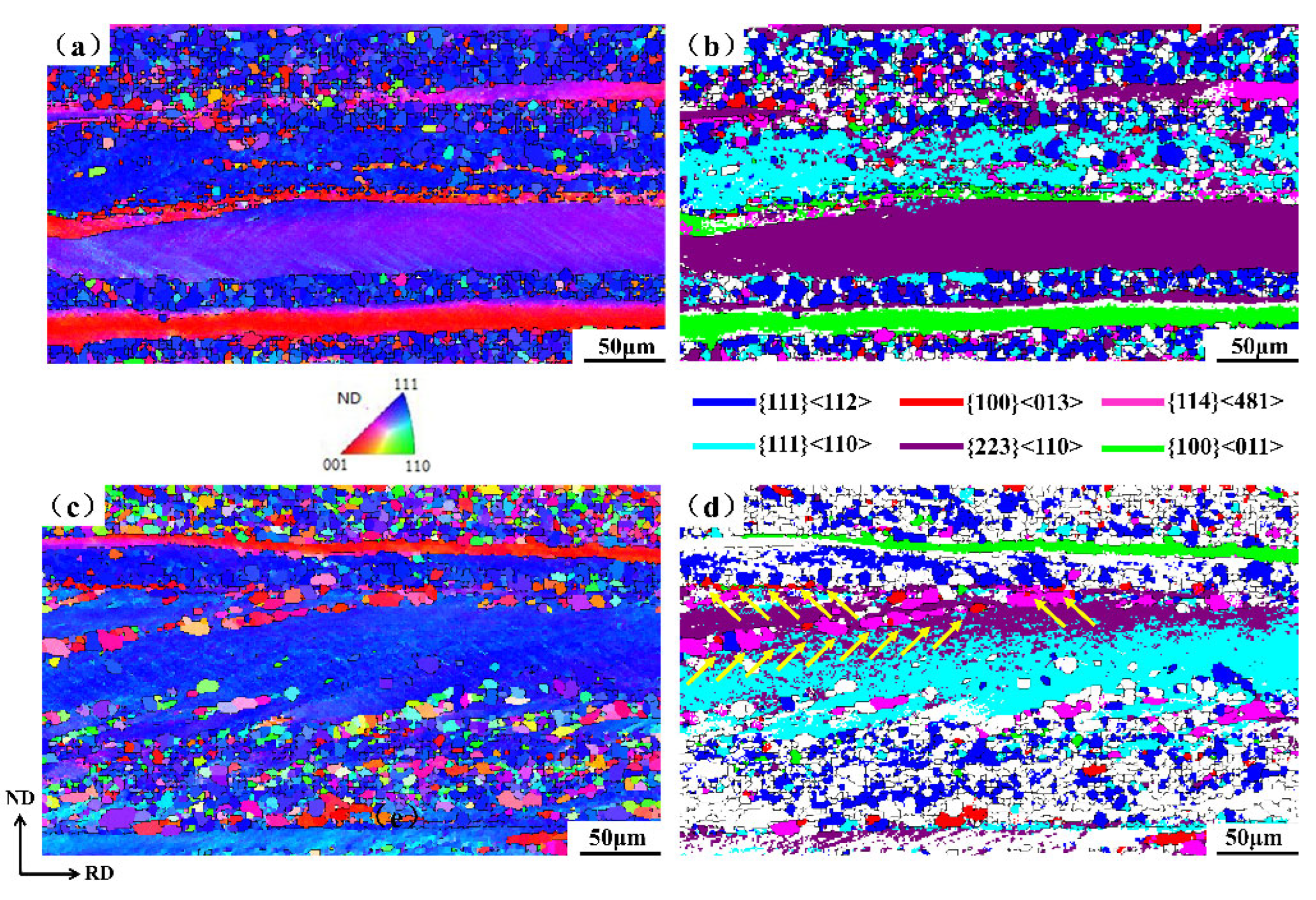

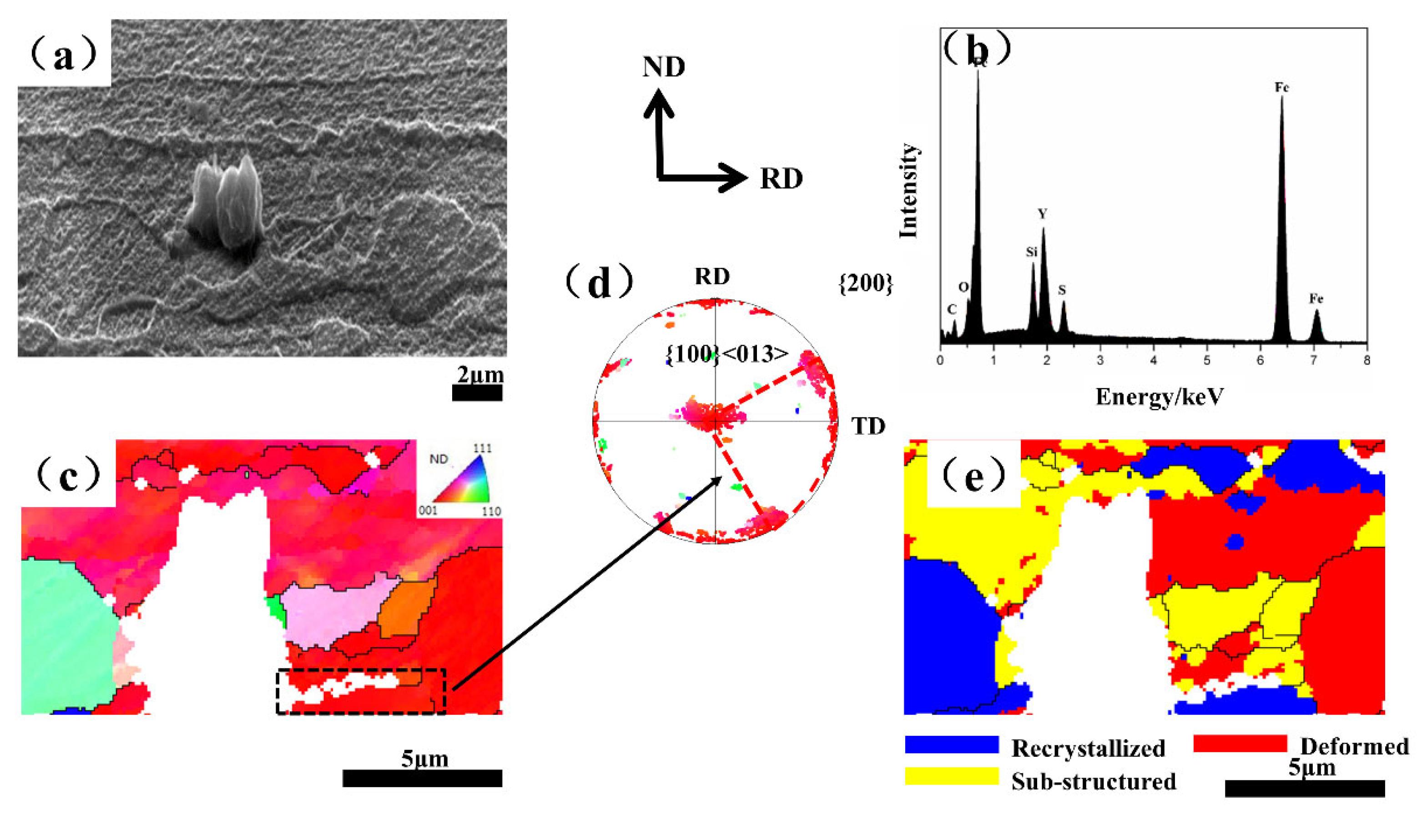
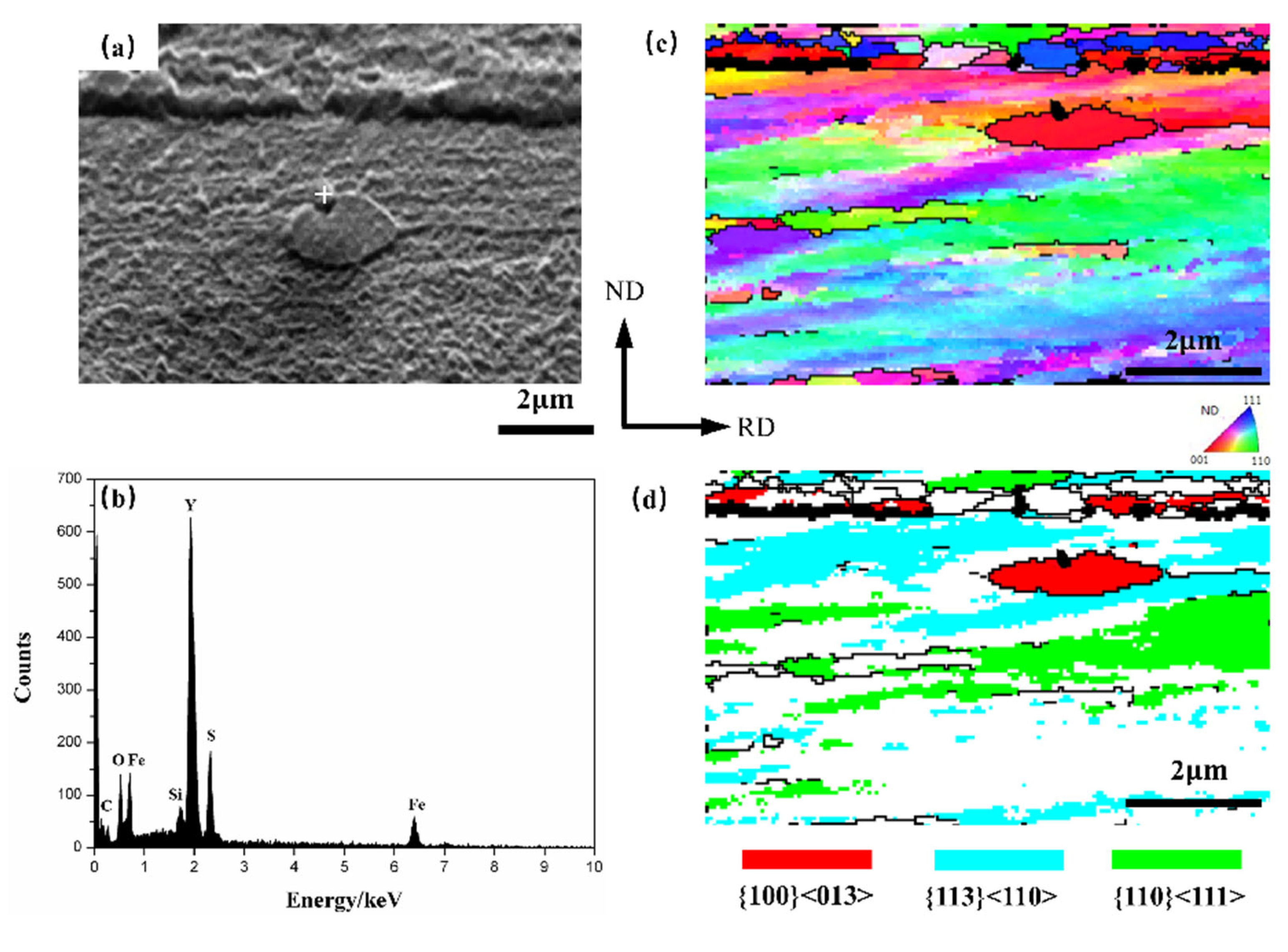

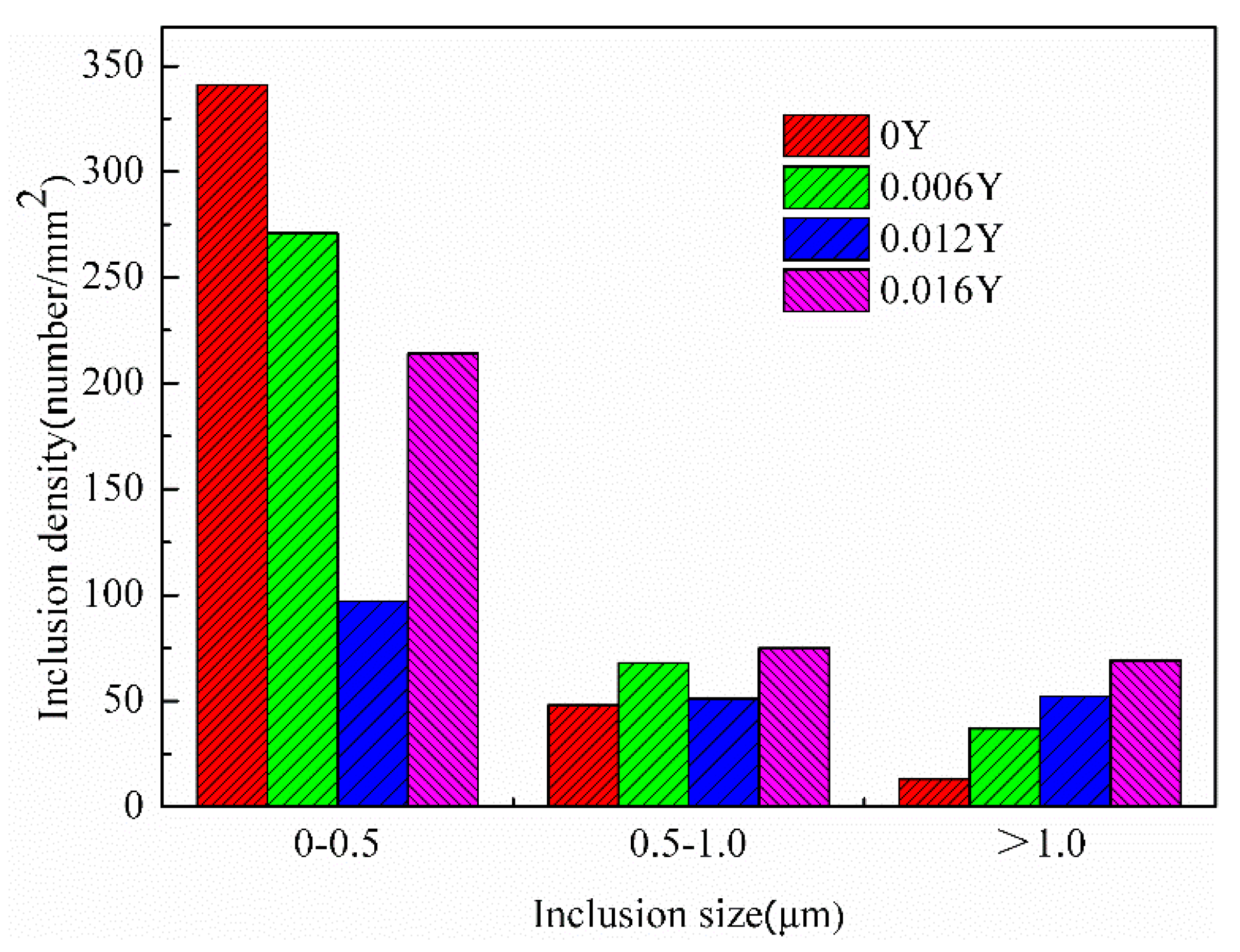

| Sample | Y | Si | C | S | O | N | Fe |
|---|---|---|---|---|---|---|---|
| 0 Y | 0 | 4.5 | 0.0025 | 0.0023 | 0.020 | 0.0014 | Bal. |
| 0.006 Y | 0.006 | 4.5 | 0.0029 | 0.0024 | 0.0017 | 0.0017 | Bal. |
| 0.012 Y | 0.012 | 4.5 | 0.0028 | 0.0018 | 0.0017 | 0.0017 | Bal. |
| 0.016 Y | 0.016 | 4.5 | 0.0025 | 0.0019 | 0.0016 | 0.0016 | Bal. |
Publisher’s Note: MDPI stays neutral with regard to jurisdictional claims in published maps and institutional affiliations. |
© 2022 by the authors. Licensee MDPI, Basel, Switzerland. This article is an open access article distributed under the terms and conditions of the Creative Commons Attribution (CC BY) license (https://creativecommons.org/licenses/by/4.0/).
Share and Cite
Qin, J.; Zhao, H.; Wang, D.; Wang, S.; Yang, Y. Effect of Y on Recrystallization Behavior in Non-Oriented 4.5 wt% Si Steel Sheets. Materials 2022, 15, 4227. https://doi.org/10.3390/ma15124227
Qin J, Zhao H, Wang D, Wang S, Yang Y. Effect of Y on Recrystallization Behavior in Non-Oriented 4.5 wt% Si Steel Sheets. Materials. 2022; 15(12):4227. https://doi.org/10.3390/ma15124227
Chicago/Turabian StyleQin, Jing, Haibin Zhao, Dongsheng Wang, Songlin Wang, and Youwen Yang. 2022. "Effect of Y on Recrystallization Behavior in Non-Oriented 4.5 wt% Si Steel Sheets" Materials 15, no. 12: 4227. https://doi.org/10.3390/ma15124227
APA StyleQin, J., Zhao, H., Wang, D., Wang, S., & Yang, Y. (2022). Effect of Y on Recrystallization Behavior in Non-Oriented 4.5 wt% Si Steel Sheets. Materials, 15(12), 4227. https://doi.org/10.3390/ma15124227







